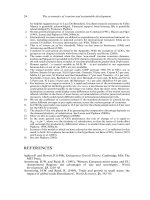THE ECONOMICS OF MONEY,BANKING, AND FINANCIAL MARKETS 379
Bạn đang xem bản rút gọn của tài liệu. Xem và tải ngay bản đầy đủ của tài liệu tại đây (45.89 KB, 1 trang )
CHAPTER 14
Risk Management with Financial Derivatives
347
additional short position, or offsets a short position by taking an additional
long position. In other words, if a financial institution has bought a security and has
therefore taken a long position, it conducts a hedge by contracting to sell that security (take a short position) at some future date. Alternatively, if it has taken a short
position by selling a security that it needs to deliver at a future date, then it conducts
a hedge by contracting to buy that security (take a long position) at a future date.
We first look at how this principle can be applied using forward contracts.
FO RWARD CO N TRACTS AN D MA RKET S
Forward contracts are agreements by two parties to engage in a financial transaction at a future (forward) point in time. Here we focus on forward contracts that
are linked to debt instruments, called interest-rate forward contracts; later in
the chapter we discuss forward contracts for foreign currencies.
Interest-Rate
Forward
Contracts
A PP LI CATI O N
Interest-rate forward contracts involve the future sale (or purchase) of a debt
instrument and have several dimensions: (1) specification of the actual debt instrument that will be delivered at a future date, (2) amount of the debt instrument to
be delivered, (3) price (interest rate) on the debt instrument when it is delivered,
and (4) date on which delivery will take place. An example of an interest-rate forward contract might be an agreement for the First Bank to sell to the Rock Solid
Insurance Company, one year from today, $5 million face value of the 6s of 2030
Canada bonds (coupon bonds with a 6% coupon rate that mature in 2030) at a
price that yields the same interest rate on these bonds as today s, say, 6%. Because
Rock Solid will buy the securities at a future date, it has taken a long position,
while the First Bank, which will sell the securities, has taken a short position.
Hedging with Interest-Rate Forward Contracts
Why would the First Bank want to enter into this forward contract with Rock Solid
Insurance Company in the first place? To understand, suppose that you are the
manager of the First Bank and have previously bought $5 million of the 6s of 2030
Canada bonds, which currently sell at par value and so their yield to maturity is also
6%. Because these are long-term bonds, you recognize that you are exposed to substantial interest-rate risk and worry that if interest rates rise in the future, the price
of these bonds will fall, resulting in a substantial capital loss that may cost you your
job. How do you hedge this risk?
Knowing the basic principle of hedging, you see that your long position in these
bonds must be offset by a short position with a forward contract. That is, you need
to contract to sell these bonds at a future date at the current par value price. As a
result you agree with another party, in this case, Rock Solid Insurance Company,
to sell them the $5 million of the 6s of 2030 Canada bonds at par one year from
today. By entering into this forward contract, you have locked in the future price
and so have eliminated the price risk the First Bank faces from interest-rate changes.
In other words, you have successfully hedged against interest-rate risk.
Why would the Rock Solid Insurance Company want to enter into the forward
contract with the First Bank? Rock Solid expects to receive premiums of $5 million









